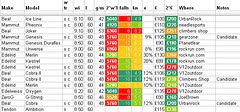 Summary: Described as “the most dangerous software on the planet,” spreadsheets regularly take the blame for data errors and financial losses. But, are spreadsheets really to blame? The fact is, businesses regularly use spreadsheets in ways they were never intended to be used. This misuse runs rampant in businesses across the globe–leading to costly mistakes on a daily basis. Is your business guilty of abusing spreadsheets in the 5 ways outlined in this article?
Summary: Described as “the most dangerous software on the planet,” spreadsheets regularly take the blame for data errors and financial losses. But, are spreadsheets really to blame? The fact is, businesses regularly use spreadsheets in ways they were never intended to be used. This misuse runs rampant in businesses across the globe–leading to costly mistakes on a daily basis. Is your business guilty of abusing spreadsheets in the 5 ways outlined in this article?

Spreadsheet programs (like Excel) are the most commonly misused/abused software programs in the business world. This misuse leads to data errors–with an estimated 88% of spreadsheets containing serious errors. These errors lead to billions of dollars in losses for businesses every year.
It’s no wonder that some call spreadsheets “the most dangerous software on the planet”.
Now, while the statistics paint a grim picture, let’s clarify one important fact: Spreadsheets are not the problem. They were designed to serve a specific role. They are single-user tools that help regular employees analyze data quickly. When used in this way, they pose little risk.
The problems arise when businesses use spreadsheets in ways they were never intended.
Unfortunately, this happens all too often. Businesses regularly turn spreadsheets into multi-user and multi-department tools. They use spreadsheets for tasks they were never designed to handle.
Today, let’s focus on these areas. In what ways do businesses commonly misuse/abuse spreadsheets?
The answer: In all sorts of ways. In fact, the list is so long, we can’t cover everything in one article. While we’ll cover more in a future article, today we’ll explore 5 common ways businesses abuse spreadsheets, and list a few problems associated with each one. Sound good? Okay, let’s dive in. Businesses abuse spreadsheets when they use them:
1. As a database
In today’s data-driven business world, your business is only as good as your data. Data quality and accessibility impacts all areas of your business, from sales, to inventory tracking, to reporting, and so much more.
The problem: Many businesses store their critical business data in spreadsheets rather than in a database.
“One of the biggest misuses of Excel I see all the time is that people refer to their spreadsheet as a ‘database’,” says Marc Weaver, Founder and CEO of Databasable, Inc. “I’ve spoken to many clients who want me to “take a look at their database” and after I ask a few questions it turns out that they are talking about a spreadsheet!”
“There are some similarities between databases and spreadsheets, obviously they both store data and a worksheet is effectively an export of a database table. However businesses (usually smaller businesses) store mission critical data in a spreadsheet rather than a specialized database platform. This means they run the risk of data loss, no recoverability, slow performance, lack of scalability and they are also missing out on the huge amount of additional features that a database offers.”
Why does this happen? In some cases, the businesses doesn’t think there’s enough data to justify a database. Others lack the technical resources to move their data to a database. Spreadsheets offer them a simple way to store their data. What happens? A year or two later, they’re still using the same spreadsheet–only it’s grown to thousands of rows and takes a few minutes to open.
Potential problems created when you use spreadsheets as a database
Security: You can’t control who accesses or updates a spreadsheet. When placed in a database, you control the data and user access.
Data Integrity: The more users that have access to a spreadsheet, the greater the risk of errors. Additionally, if data becomes corrupted or deleted, spreadsheets are not easily rolled back to a previous state.
It limits the business: Spreadsheets don’t handle relational data. For instance, suppose you keep customer order history in one spreadsheet, and customer account details in another. A database lets you tie this information together, but a spreadsheet does not.
2. As a CRM system

A customer relationship management system helps a business manage both prospects and customers. It tracks all interactions with the business, from emails, to phone calls, to appointments, and everything in between.
The problem: Many businesses make the mistake of trying to handle all of these tasks with spreadsheets. While this approach does let them store contacts, it lacks the features that make a CRM system truly useful.
“The most common misuse of any spreadsheet program is to utilize it as a client management system,” says Lee McCormick, media relations officer at Pre Settlement Funding, Inc. “Excel was not meant for managing leads or clients; it’s not practical, there’s no scheduling option nor does it sync with email (or any other app, for that matter). In short, utilizing spreadsheets to manage leads/clients is a horribly inefficient—yet surprisingly popular—misuse of the tool.”
Potential problems created when you use spreadsheets as a CRM system
Productivity loss: With spreadsheets, nothing is automated. Employees must manually update records with any new information on that prospect/customer. With a CRM system, much of this information is automatically integrated.
Lack of accessibility: Only one user can edit a spreadsheet at a single time. Additionally, spreadsheets are only accessible from inside the office–whereas a CRM system is available on any web-connected device.
Data loss: With so many employees updating a single file, you risk mistakes and data loss. Do you really want to risk the loss of your customer/prospect data?
3. As Project Management and Workflow Tools
As mentioned earlier, spreadsheets work just fine as single-user tools. When used to track your own projects or keep tabs on your to-do list, there’s no harm in using a spreadsheet.
However, as soon as you start branching out into multi-user project management, problems arise. With so many different users all relying on the same spreadsheet, data errors are likely. For instance, here’s a great example of what can happen when you use spreadsheets for project management.
“A client of ours uses spreadsheets to track the numerous “projects” they have going with their customers,” says Jody Jankovsky, Managing Member, Founder, Black Line Consulting. “There are three groups of people who need access to project information at various times through the process: Project Managers, Administrative support and Accounting. Project Managers identify tasks, adjust dates and generally assign tasks. The Administrative support team works on projects, documents results and completes the tasks. Accounting bills customers, updates billing status and notes billing issues for Project Managers. With so many people (15 or so) needing access to this information to review, adjust, and report, they experience numerous problems. Spreadsheets get corrupted easily, people make copies so they can get their part of the job done (while someone has one open) and then “combine” their work later. When so many people are playing games with the data, accuracy is lost and time is wasted as data has to be rebuilt when problems occur. We are called on to restore or fix spreadsheets a couple times per month. Basically, it’s an inefficient disaster.”
Potential problems created when you use spreadsheets for project management or workflow
Multiple versions of the truth: As mentioned above, multiple users save the document locally so they can make changes. With so many versions floating around, how do you know which one is accurate?
Lack of features: Spreadsheets lack the automation features found in traditional workflow software. For instance, when one part of a project requires approval, workflow software emails the appropriate manager for approval. Without these workflow features, the project will frequently stall.
Lack of accessibility: With spreadsheet-based project management, the file is only accessible locally. On the flip side, project management or workflow applications are typically accessible from any web-connected device.
4. As an integration tool

Many businesses run on different systems. For instance, a single company might use one piece of software for their operations, another for their eCommerce site, and another warehouse management. Or, different departments within the same company might use different pieces of software.
The problem is, these systems don’t always communicate with each other. How do they tie all of their data together? For many, the answer is spreadsheets.
“Because data from different departments rarely fits together, Excel often becomes the cobbled collaboration tool,” says Seline Karakaya, Chief Operating Officer at The Kini Group. “This results in slow, heavy, and basically unusable documents chained together. The point is to connect the data and see how departmental decisions and strategies affect one another, but these spreadsheets often fail to achieve this goal, muddying and confusing the data instead. Even worse, departments end up with multiple versions of documents, because everyone’s trying to update their information at once. This adds another layer of complication by forcing companies to schedule out how they update their spreadsheets. In short, Excel is great for small, one-person reports, but it is not a tool for database application development.”
Potential problems created when you use spreadsheets for integration
You rely on old data: Using spreadsheets to cobble together data from multiple systems is a slow process. By the time the data is pulled out of each system, combined, and formatted, the data is a week old.
It wastes time: On the same note, think of all of the time that this process wastes. I remember running across one company facing this problem. They had an employee who spent half of his time every week manually integrating data from multiple systems.
It’s hard to get a clear view of your business: With this approach, you can never look at your data and understand how your business is doing at that very moment.
5. As a budgeting tool
Budgeting presents a challenge to many businesses. Why? For some, they just can’t find software that fits their unique budgeting process. For others, budget data resides across multiple systems that don’t communicate with each other.
What do they do? The go-to solution to these budgeting problems is often a spreadsheet program. They pull the data into a spreadsheet, and create their budgets from there.
As you can imagine, this is a time consuming process. I’ve seen companies where budgeting is a month-long process. I’ve seen employees who spend half of their time creating budgets on spreadsheets.
Potential problems created when you use spreadsheets for budgeting
Productivity: This is an unnecessarily time-consuming process. If these businesses built budgeting applications that tied together with their existing systems, they could automate the budgeting process.
Data inaccuracies: Every time an employee touches your data outside of your database, you risk data inaccuracies. A simple misclick can throw your numbers off dramatically–creating major problems for your business.
Confusion: Spreadsheet-based budgets are typically distributed via email. The problems arise when different users make adjustments to the budget. Soon, you’re stuck with multiple versions of the same budget–and you don’t know which one is accurate.
Summary
Now, these are just a few ways businesses misuse/abuse spreadsheets. Stay tuned for Part 2, where we’ll explore even more common practices. If you would like to add anything to this list, I’d love to hear it. Feel free to share in the comments.
Agreed very much with this article. Nevertheless, people like to use spreadsheet because it’s easy to use and they don’t use database because they don’t know how to get started with a database. BAU DB is a real database program that lets people create database applications as easy as using a spreadsheet. No need to build anything and go straight to data entry work. It uses cells and SQL formulas to manipulate data and integrated Excel for pre-formatted document or report templates. It’s baudb.com.
Pingback: 6 Ways To Raise Your Business Intelligence To The Next Level – WTW Jasa Sdn Bhd
Pingback: 6 Ways To Raise Your Business Intelligence To The Next Level